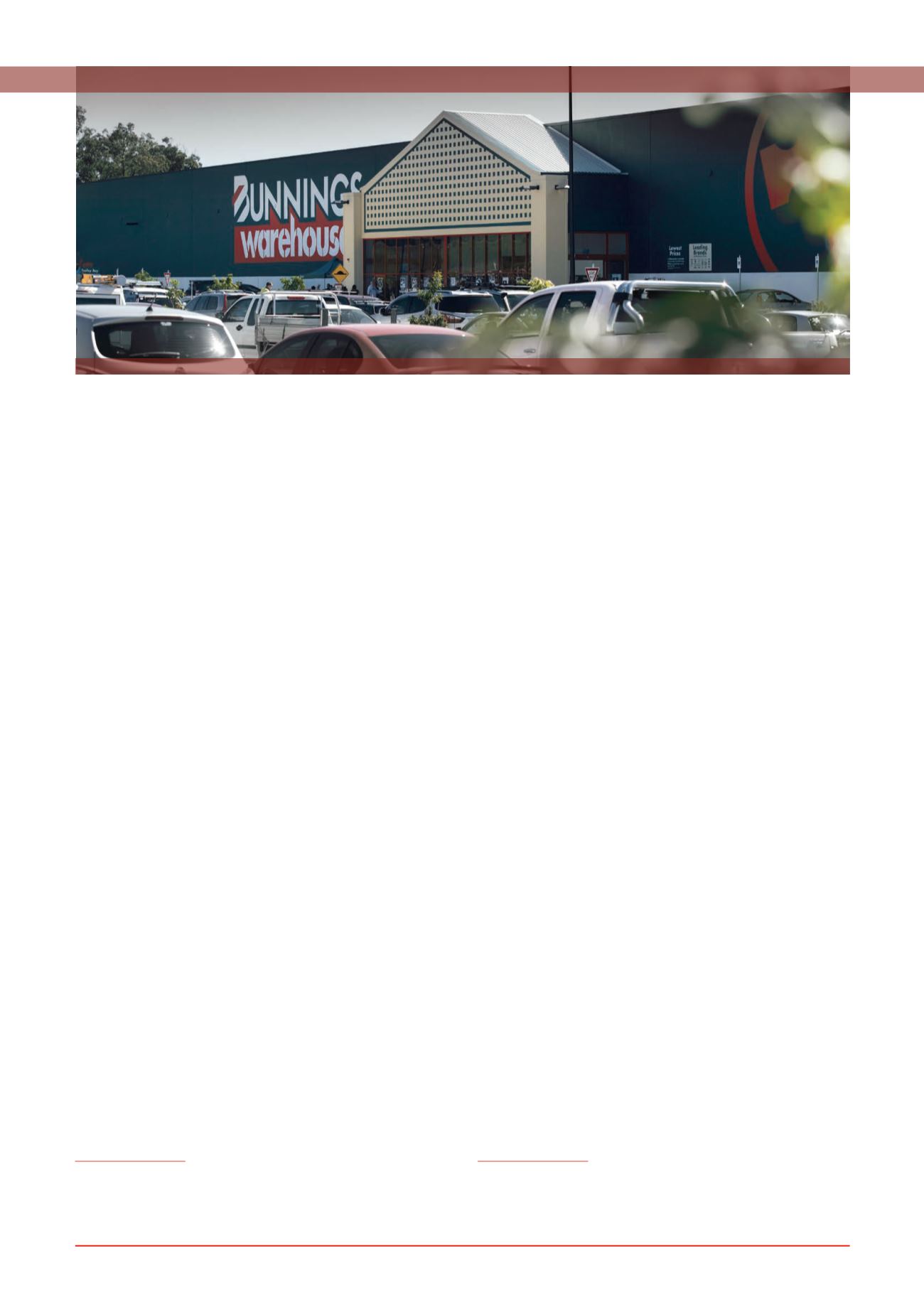
BWP TRUST ANNUAL REPORT 2015
Brendale, QLD
8
Due to the accounting requirement to mark the value of interest
rate swap hedges to market, the Trust’s hedging liabilities
decreased to approximately $10.9 million as at 30 June
2015 (2014: $12.1 million). The decrease in hedging liability
during the year was due to the reduction in the average term
of maturity of the interest rate swap profile. The hedging
liability assesses the potential liability if all hedges were to be
terminated at 30 June 2015.
GEARING
The Trust’s gearing ratio (debt to total assets) at 30 June 2015 was
24.1 per cent (2014: 24.4 per cent), which is at the middle of the
Board’s preferred range of 20 to 30 per cent. Covenant gearing
(debt and non-current liabilities to total assets) was 24.6 per cent
(2014: 25.0 per cent) which is well within the Trust’s debt covenant
requirements. The interest cover ratio (earnings before interest and
tax/interest expense) was 5.1 times (2014: 5.7 times), also well
within the Trust’s debt covenant requirements.
OPERATING ENVIRONMENT
BUNNINGS – THE TRUST’S KEY CUSTOMER
Bunnings is the leading retailer of home improvement and outdoor
living products in Australia and New Zealand, and a major supplier
to project builders, commercial tradespeople and the housing
industry. Bunnings has a network of approximately 232 Bunnings
Warehouse stores across Australia and New Zealand, around 66
smaller format stores and 32 trade centres
1
.
As at 30 June 2015, approximately 93 per cent of the Trust’s
annual rental income is from Bunnings and therefore the Trust’s
earnings are linked to the ongoing success of the Bunnings
business and the strength and direction of the underlying home
improvement and outdoor living markets.
For the financial year ended 30 June 2014, Bunnings reported
revenue of $8.546 billion, and EBIT of $979 million
2
. In the period
from 30 June 1995 to 30 June 2014, Bunnings grew sales and
earnings before interest and tax (“EBITâ€), at a compound annual
1
Source: Wesfarmers Briefing Day Materials, 20 May 2015, page 92, 93
and 95
2
Source: Wesfarmers 2014 full-year results announcement, 20 August 2014,
page 11
growth rate of 16.4 per cent per annum, and 20.8 per cent per
annum, respectively
3
.
For the nine month period ended 31 March 2015, Bunnings
reported sales of $7.293 billion, up 11.9 per cent on the previous
corresponding period
4
.
At a recent Wesfarmers Strategy Briefing Day, Bunnings outlined
its 2015/16 strategic agenda with a continuing focus on driving
growth through creating more customer value, better customer
experiences, greater brand reach, expanding its commercial
business, and through more merchandising innovation
5
.
At the strategy day, Bunnings indicated its intention to further
expand its physical network in all formats including smaller and
Bunnings Warehouse format stores, multi-level and elevated
stores, trade centres, and hybrid stores, incorporating elements of
trade centres into selected large Bunnings Warehouse stores.
With the ongoing evolution of the Bunnings business model and
store formats, periodically Bunnings vacates existing sites, and
relocates to new purpose built stores. The Trust has seven stores in
its portfolio that Bunnings has or is in the process of moving out of.
In each case the stores are currently still leased to Bunnings. For
each site the Trust is well progressed in re-leasing, re-formatting and
leasing, and/or divesting, depending on which approach provides
the best financial outcome.
Merchandise innovation remains a key driver of growth for Bunnings.
At the strategy day, Bunnings highlighted a number of mega trends
that it believes will support its ongoing growth including; population
growth and urbanisation, sustainability and energy efficiency, ageing
population and independent living needs, automation and intelligence
technologies for homes and gardens, and ongoing product innovation
across the entire spectrum of home improvement and outdoor living
6
.
HOME IMPROVEMENT AND OUTDOOR LIVING MARKET
Bunnings estimates the size of its addressable market in home
improvement and outdoor living to be sales of $46 billion per
annum, of which its share is 18 per cent. A number of factors
drive the growth of the home improvement and outdoor living
3
Source: Wesfarmers Strategy Briefing Day, 20 May 2015, page 72
4
Source: Wesfarmers third quarter results announcement, 29 April 2015, Page 1
5
Source: Wesfarmers Strategy Briefing Day, 20 May 2015, page 84
6
Source: Wesfarmers Strategy Briefing Day, 20 May 2015, page 102
BUSINESS REVIEW


